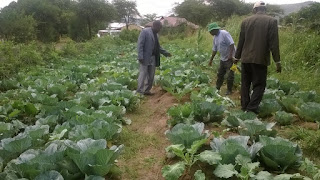 Vertical garden
innovation has brought about major breakthrough in urban agriculture. Land
remains a key factor in production, however with increasing population and that
land as a factor of production is limited in nature makes its access and
utilization dwindle with time. Land use conflicts have formed African history
from time of scrabble for Africa by white settlers to modern day conflicts.
This calls upon innovations and creativity in land utilization both in rural and
urban areas
Vertical garden
innovation has brought about major breakthrough in urban agriculture. Land
remains a key factor in production, however with increasing population and that
land as a factor of production is limited in nature makes its access and
utilization dwindle with time. Land use conflicts have formed African history
from time of scrabble for Africa by white settlers to modern day conflicts.
This calls upon innovations and creativity in land utilization both in rural and
urban areas
Vertical gardens
have brought about such needed solution whereby farmers in urban areas or those
with limited land can still be able to farm of the space. The innovation makes
use of PVC pipes in which crops are planted on holes made of the PVC pipes and
then crops planted. Depending on the size of the PVC pipes and the strength of
the base, different numbers and variety of crops can be planted
PROCESS OF ESTABLISHING VERTICAL GARDEN
Stage 1
 A PVC pipe of
different size and shape is acquired and trimmed to required size. It’s then
corked from both sides to ensure that no leakage of soil water and manure.
Holes are then made on one side of the pipe, the spacing of the holes is
dependence of crops to be planted on the vertical garden. The PVC pipes can be
easily acquired from hard ware stores and super markets.
A PVC pipe of
different size and shape is acquired and trimmed to required size. It’s then
corked from both sides to ensure that no leakage of soil water and manure.
Holes are then made on one side of the pipe, the spacing of the holes is
dependence of crops to be planted on the vertical garden. The PVC pipes can be
easily acquired from hard ware stores and super markets.
Stage 2
Strong support
system for the pipes is developed. This can be made from metal bars or wooden
posts. This ensures that the PVC pipes are suspended horizontally on the space and
irrigation can be carried out without water flowing out. Drip irrigation kit is
then established with water tank of convenient size place above the vertical
garden and drip lines passed through the PVC pipes with tiny opening for
ensuring convenient water drops to irrigate the crops. In case the drip line
system is not convenient then the vertical garden can be irrigated manually.
Stage 3
The PVC pipes
are then filled with mixture of manure and soil. However the soil mixture needs
not to be compressed to allow easy root penetration for the crops. Crop seeds
or seedlings are then planted on the holes made on the PVC and irrigated
depending on their water requirement
1. There
is maximum water efficiency because water is only put at the crop base either
through drip system or manually
2. Does
not require much space since the garden takes vertical extension instead of
horizontal extension
3. Requires
minimal maintenance costs because once it has been properly installed no much
work is needed in future
4. Materials
for establishing vertical gardens are easily available i.e. PVC pipes, soils,
manure, metal bars and wooden posts
5. Does
not require skilled labour for its development and it’s not labour intensive
Conclusions
 Vertical gardens
have proofed to be convenient innovation for household vegetable requirement.
In urban settings, they can be developed on balconies and verandah while on
rural areas they can be established within the homestead compound. In public
utilities such as schools, hospitals and churches such garden can provide
convenient subsidies for vegetable requirements and save the money which would
have otherwise been spent to acquire such vegetables. Inades Formation Kenya
has supported two groups in Mwala and Matinyani who have installed similar
vertical gardens and have lauded then innovation as the future for small scale farmers in arid and semi arid areas and
urban population
Vertical gardens
have proofed to be convenient innovation for household vegetable requirement.
In urban settings, they can be developed on balconies and verandah while on
rural areas they can be established within the homestead compound. In public
utilities such as schools, hospitals and churches such garden can provide
convenient subsidies for vegetable requirements and save the money which would
have otherwise been spent to acquire such vegetables. Inades Formation Kenya
has supported two groups in Mwala and Matinyani who have installed similar
vertical gardens and have lauded then innovation as the future for small scale farmers in arid and semi arid areas and
urban population
Article by
Andrew Muendo Nyamu
Project Officer- Inades Formation Kenya
Email: nyamu1895@gmail.com
Phone number: 0722962986
www.andrewnyamuconservation.blogspot.co.ke




















